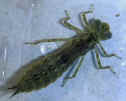| Size is a great determining factor in deciding what
eats what in a pond. Generally, a larger carnivore will eat any smaller carnivores in its
vicinity which it can catch. Insects in the larval stage of
their lifecycle, will pass through several different moults (known as instars) before
becoming adult. They increase in size with each moult of their restricting external
skeleton. They therefore grow in jumps, rather than continuously as we do when young.
Thus, a large Great Diving Beetle larva which is close to becoming an adult, may eat a
small dragonfly larva. On another occasion, the tables may be turned and a large dragonfly
larva may eat a small Great Diving Beetle larva. Equally, fully grown sticklebacks may eat
tiny dragonfly larvae, but a small stickleback may also be captured and eaten by a large
dragonfly larva.
There is often cannibalism within the species, with individuals
being eaten by other more aggressive ones of the same species. In general, smaller
individuals will be eaten by larger ones, but this is not always the case. In this
excellent movie clip (1.4Mb), a Great
Diving Beetle larva can be seen eating another of a similar size.
For simplicity, the lower level carnivores in the pond have all been
grouped into a single trophic level in the foodweb. However, because of the size factor,
this third level may actually develop into several different additional levels. For
example, a very small Greater Waterboatman which has just eaten a first instar Mayfly
larva, may then be eaten in turn by a late instar Great Diving Beetle larva.
Plants > Mayfly larva
> Greater Waterboatman > Great Diving Beetle
Larva
This is therefore a food chain with 4 trophic levels rather than 3. |
| There are many more detritivores in the pond than the
snails and Lesser Waterboatmen illustrated in the foodweb. Other detritivores include
Flatworms of various different species and Water Lice. These detritivores fulfill just as
vital a role as their counterparts on dry land. Dead and decaying plant and animal
material in the pond is all recycled, with the help of detritivores, into reusable
nutrients for uptake by water plants. The Pond Skater in the
foodweb feeds largely off other invertebrates which fall into the water and drown. Adult
insects, such as Mayflies, emerging from the aquatic stage of their life history, may also
be unsuccessful and drown. The Pond Skater is a carnivore rather than a detritivore
because it is drawn to the frantic struggles of drowning insects and is usually consuming
live food rather than dead and decaying bodies. |
| The feeding interactions which go on in a habitat such
as a pond are incredibly complex. A foodweb is an attempt to simplify these interactions
to an extent where we are able to reach some understanding of what is going on. However,
it is worth remembering that it is just that - an extreme simplification. The feeding preferences of individual animals alter as they grow. They may
also seek different food choices depending on what is currently available, the particular
environmental conditions at any one time, the microhabitats which are available in a
particular pond, as well as the time of day (a food web drawn just for the night period
would look substantially different). Individuals of different sexes within the same
species may even make different food choices. |




 Size and
Trophic Levels
Size and
Trophic Levels Detritivores (animals
which feed on decaying organic material)
Detritivores (animals
which feed on decaying organic material)

